📞+86 153 7530 2641 📧 hongjing.Wang@feichuncables.com

Feichun (N)TMCGCW11Y High Flexible Medium Voltage Cable for Offshore Power & Transformer Connections
Discover the Feichun (N)TMCGCW11Y flexible screened single core cable. Perfect for transformer houses, energy chains, and shore power systems requiring a small bending radius under medium voltage applications.
hongjing.Wang@Feichun
8/8/202510 min read

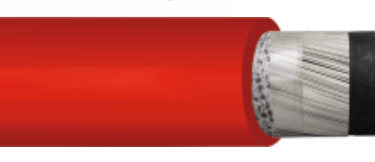
Introduction
The Feichun (N)TMCGCW11Y represents a breakthrough in medium voltage cable technology, specifically engineered for applications demanding exceptional flexibility combined with robust electrical performance. This high-performance screened single core cable, manufactured according to stringent DIN VDE 0250-813 standards, addresses the critical need for reliable power transmission in challenging industrial environments where traditional cables fall short.
Built with advanced materials and precision engineering, the (N)TMCGCW11Y cable excels in applications requiring frequent movement, tight bending radii, and resistance to harsh environmental conditions. Its unique design incorporates multiple voltage ratings from 3.6/6 kV up to 18/30 kV, making it suitable for diverse medium voltage applications across offshore platforms, industrial facilities, and mobile machinery systems.
The cable's superior flexibility stems from its carefully engineered conductor stranding and specialized insulation system, enabling deployment in energy chains, reeling operations, and confined spaces where conventional cables would fail. This combination of mechanical resilience and electrical reliability makes it an ideal choice for modern industrial applications demanding both performance and longevity.
Technical Specifications
Conductor and Insulation Materials
The (N)TMCGCW11Y features a meticulously designed conductor system utilizing tinned copper wires arranged in fine stranding configuration, meeting Class 5 requirements according to DIN EN/IEC 60228. This construction ensures optimal flexibility while maintaining excellent electrical conductivity and corrosion resistance in marine environments.
The insulation system employs a sophisticated multi-layer design featuring an inner semi-conductive stress control layer that ensures uniform electric field distribution. The primary insulation consists of EPR (Ethylene Propylene Rubber) compound formulated with enhanced electrical and mechanical characteristics according to DIN VDE 0207-20 standards. An outer semi-conductive insulation shield layer completes the insulation system, providing comprehensive protection against electrical stress and environmental factors.
Thermal and Mechanical Parameters
The cable demonstrates exceptional thermal performance across a wide operating range. For fixed installations, the ambient temperature range spans from -50°C to +90°C, while flexible operations are supported from -40°C to +90°C. The maximum permissible conductor temperature reaches 90°C during normal operation, with short-circuit capability up to 200°C at the conductor level.
Mechanical specifications include a maximum tensile load of 15 N/mm² per conductor, ensuring durability under challenging installation conditions. The bending radius requirements vary based on application: fixed installations require a minimum of 6 times the outer diameter, while free-moving applications demand 8 times the outer diameter. These parameters enable deployment in space-constrained environments while maintaining cable integrity.
Movement speed capabilities vary significantly based on application requirements. Shore power systems typically operate at 6 m/min, while energy chains on cranes can accommodate speeds ranging from 70 to 240 m/min, demonstrating the cable's versatility across different operational demands.
Voltage Ratings and Test Voltages
The (N)TMCGCW11Y series encompasses multiple voltage ratings to accommodate diverse application requirements. The 3.6/6 kV variant supports maximum permissible operating voltages of 4.2/7.2 kV in AC systems and 5.4/10.8 kV in DC systems. The 6/10 kV version handles 6.9/12 kV AC and 9/18 kV DC, while the 8.7/15 kV model accommodates 10.4/18 kV AC and 13.5/27 kV DC applications.
Higher voltage variants include the 12/20 kV (13.9/24 kV AC, 18/36 kV DC), 14/25 kV (17.3/30 kV AC, 22.5/45 kV DC), and the premium 18/30 kV version supporting 20.8/36 kV AC and 27/54 kV DC operations. These comprehensive voltage options ensure optimal matching for specific application requirements while maintaining safety margins.
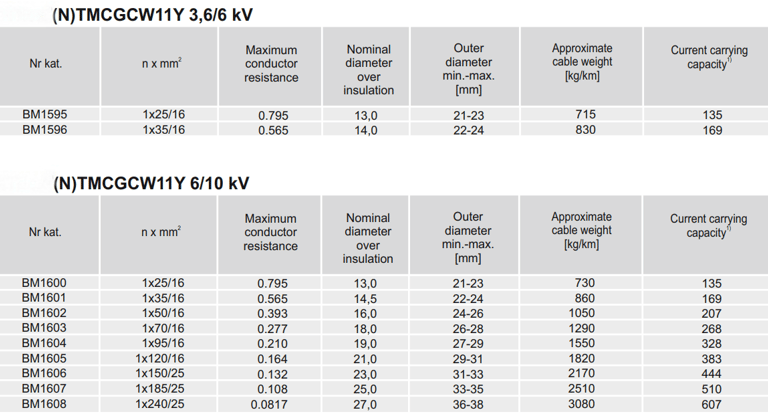

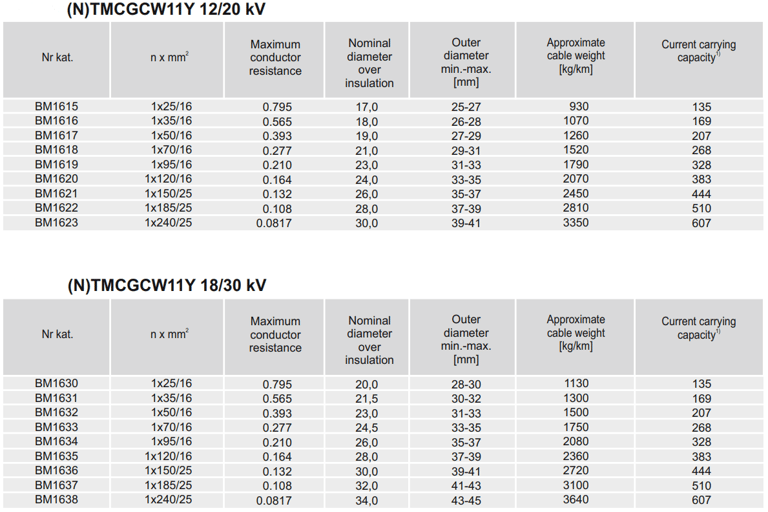

Design and Construction
Semi-Conductive Stress Control Layers
The cable's sophisticated stress control system employs strategically positioned semi-conductive layers that manage electrical field distribution throughout the insulation system. The inner semi-conductive layer, applied directly over the conductor, ensures smooth field transition from the conductor to the insulation material, eliminating potential stress concentration points that could lead to premature failure.
This design approach significantly enhances the cable's electrical performance and longevity, particularly crucial in medium voltage applications where field management becomes critical. The outer semi-conductive shield provides additional protection while facilitating proper grounding connections essential for safe operation.
EPR Compound Insulation
The primary insulation utilizes advanced EPR compound technology specifically formulated for demanding applications. This material offers superior electrical properties including high dielectric strength, low dielectric losses, and excellent resistance to electrical treeing. The compound's mechanical properties provide flexibility while maintaining structural integrity under repeated bending cycles.
The EPR insulation demonstrates exceptional resistance to thermal aging, ozone exposure, and chemical attack, ensuring consistent performance throughout the cable's operational life. Its formulation according to DIN VDE 0207-20 standards guarantees compliance with stringent quality requirements for medium voltage applications.
Concentric Ground Conductor Design
The protective conductor system features a concentric ground conductor configuration utilizing tinned copper wire strands arranged according to DIN VDE 0250-1 specifications. This design provides approximately 85% coverage, ensuring effective fault current handling and electromagnetic shielding performance.
The concentric arrangement offers several advantages including uniform current distribution during fault conditions, improved mechanical flexibility compared to tape shields, and simplified termination procedures. This configuration particularly benefits applications requiring frequent cable movement where traditional shielding methods might fail.
Polyether Polyurethane Outer Sheath
The outer sheath employs thermoplastic polyether-based polyurethane conforming to EN 50363-10-2 standards, providing comprehensive protection against environmental factors. This advanced material offers exceptional resistance to oil (per EN 60811-404), UV radiation, moisture, and mechanical abuse while maintaining flexibility across the specified temperature range.
The sheath's flame retardant properties, tested according to EN 60332-1-2, ensure safety in industrial environments. The material's water resistance capabilities enable operation in submerged conditions up to 10 bar pressure, qualifying for protection class AD8 applications. The distinctive red color with inkjet marking facilitates identification and installation procedures.

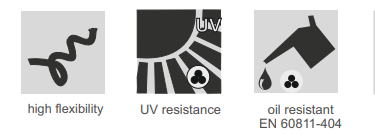
Performance Characteristics
Bending Radius Requirements
The (N)TMCGCW11Y's exceptional flexibility manifests in its minimal bending radius requirements, a critical factor for installations in confined spaces. Fixed installation applications require a minimum radius of 6 times the cable's outer diameter, while dynamic applications demand 8 times the outer diameter. These specifications enable deployment in transformer houses, switchgear compartments, and cable management systems where space constraints are paramount.
The cable's ability to maintain these tight bending radii without performance degradation stems from its optimized conductor stranding, flexible insulation system, and specialized sheath material. This combination ensures long-term reliability even under repeated flexing cycles common in mobile applications.
Temperature Performance
Operating temperature ranges demonstrate the cable's versatility across diverse environmental conditions. Fixed installations support ambient temperatures from -50°C to +90°C, accommodating extreme climate conditions found in offshore platforms and industrial facilities. Flexible operations maintain performance from -40°C to +90°C, suitable for energy chain applications and mobile machinery.
The maximum conductor temperature of 90°C during continuous operation provides substantial current carrying capacity while maintaining safety margins. Short-circuit performance up to 200°C ensures protective device coordination and system safety during fault conditions.
Environmental Resistance
Comprehensive environmental resistance capabilities make the (N)TMCGCW11Y suitable for challenging industrial applications. Oil resistance, tested according to EN 60811-404 standards, ensures reliable operation in hydraulic systems and industrial environments where hydrocarbon exposure is common.
UV resistance enables unrestricted outdoor use without degradation, while ozone resistance prevents cracking in high-voltage environments. Moisture resistance combined with water immersion capability up to 10 bar pressure expands application possibilities to marine and underwater installations.
Current Carrying Capacity
Current ratings vary based on conductor size and voltage level, optimized according to IEC 60364-5-52 standards. The 6/10 kV series ranges from 135A for 25 mm² conductors to 607A for 240 mm² configurations. Higher voltage variants maintain similar current levels while providing increased power transmission capability.
These ratings assume 90°C conductor temperature with 30°C ambient conditions in free air installation per method F with three loaded conductors in trefoil configuration. Alternative installation methods and specific environmental conditions may require derating calculations available upon request.

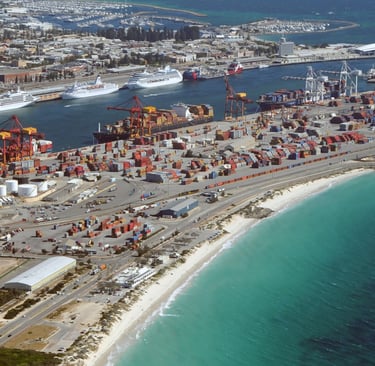
Typical Applications
Transformer Houses and Switchgear Connections
The (N)TMCGCW11Y excels in transformer house applications where space limitations demand cables with minimal bending radius capabilities. Its compact design enables efficient routing through cable galleries, transformer chambers, and switchgear compartments where conventional cables prove impractical.
The cable's high voltage capability and robust insulation system provide reliable connections between transformers, switchgear, and distribution equipment. Its flexibility simplifies installation procedures while reducing installation time and labor costs in confined spaces.
Energy Chains on Cranes and Offshore Systems
Offshore power systems and crane applications benefit significantly from the cable's dynamic performance characteristics. Energy chain installations subject cables to continuous flexing cycles, temperature variations, and mechanical stresses that would quickly degrade conventional designs.
The (N)TMCGCW11Y's specialized construction enables operation in energy chains at speeds up to 240 m/min, supporting high-performance crane systems and automated material handling equipment. Its environmental resistance ensures reliable operation in marine atmospheres and industrial environments.
Shore Power Systems for Container Vessels
Container vessel shore power connections demand cables capable of handling medium voltage power while accommodating vessel movement and docking procedures. The (N)TMCGCW11Y's flexibility and environmental resistance make it ideal for these applications where cables must withstand repeated connection cycles and exposure to marine environments.
Shore power systems typically operate at 6 m/min movement speeds, well within the cable's capability range. The cable's water resistance and environmental protection enable reliable operation in port facilities where exposure to weather and contamination is common.
Cable Carrier Systems for Large Drives
Industrial drive systems increasingly rely on cable carrier configurations for power distribution to mobile equipment and automated machinery. The (N)TMCGCW11Y's combination of flexibility, current carrying capacity, and mechanical durability makes it suitable for these demanding applications.
Large electrical drives benefit from the cable's ability to maintain consistent electrical performance despite continuous movement and mechanical stress. Its design accommodates the repetitive flexing cycles common in automated manufacturing and material handling systems.

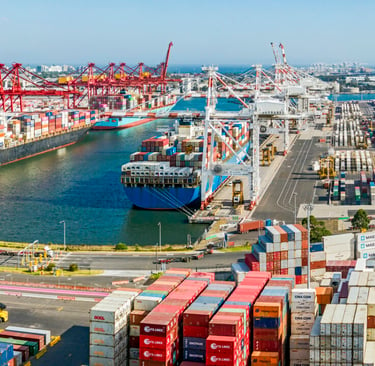
Standards and Approvals
DIN VDE and IEC Compliance
The (N)TMCGCW11Y maintains strict compliance with DIN VDE 0250-813 standards, ensuring consistent quality and performance characteristics. Conductor design meets DIN EN/IEC 60228 Class 5 requirements, guaranteeing optimal flexibility and electrical performance.
Insulation system compliance with DIN VDE 0207-20 ensures appropriate electrical characteristics and long-term reliability. These standards provide confidence in the cable's performance across diverse applications and environmental conditions.
Fire Performance and Safety Standards
Fire performance testing according to EN 60332-1-2 demonstrates the cable's flame retardant characteristics, essential for safe operation in industrial and marine environments. The outer sheath formulation provides controlled burning behavior that limits fire spread while maintaining structural integrity during emergency conditions.
These safety characteristics comply with international maritime and industrial safety requirements, enabling deployment in applications where fire safety is paramount.
Oil Resistance and Chemical Testing
Comprehensive oil resistance testing per EN 60811-404 validates the cable's performance in hydraulic systems and industrial environments where hydrocarbon exposure is common. This testing ensures long-term material stability and electrical performance despite chemical exposure.
The testing protocol evaluates both short-term and long-term exposure effects, providing confidence in the cable's durability across its operational life span.
International Certifications
UL certification under certificate number UL-US-2322575-0/E524140-20230602 provides North American market access and compliance with local electrical codes. RoHS 2015/863/EU compliance ensures environmental responsibility and European market access.
CPR 305/2011 compliance addresses construction product regulations, enabling use in construction applications throughout the European Union. These certifications demonstrate the cable's global applicability and regulatory compliance.






Ordering Information and Customization
Available Cross-Sections and Configurations
The (N)TMCGCW11Y series offers comprehensive conductor size options from 25 mm² to 240 mm², accommodating diverse current carrying requirements. Standard configurations include single-core designs optimized for specific voltage levels and application requirements.
Conductor options include 25/16, 35/16, 50/16, 70/16, 95/16, 120/16, 150/25, 185/25, and 240/25 configurations, with the second number indicating stranding class. This range provides optimal matching for specific current and flexibility requirements.
Catalog Numbers and Technical Specifications
Each configuration features specific catalog numbers for precise ordering and specification. The 6/10 kV series includes BM1600 through BM1608, while the 18/30 kV series spans BM1630 through BM1638. Detailed technical specifications including resistance, diameter, weight, and current ratings accompany each catalog number.
Technical datasheets provide comprehensive installation guidelines, derating factors, and application-specific recommendations to ensure optimal performance in specific installations.
Custom Manufacturing Capabilities
Beyond standard configurations, custom cross-sections and core counts are available upon customer request. This flexibility enables optimization for specific applications where standard configurations may not provide ideal performance characteristics.
Custom manufacturing capabilities include modified conductor sizes, specialized sheath colors, extended length requirements, and application-specific testing protocols. Lead times and minimum order quantities vary based on customization requirements.
Frequently Asked Questions
Q: What is the minimum bending radius for the (N)TMCGCW11Y cable? A: The minimum bending radius depends on the application type. For fixed installations, the minimum radius is 6 times the outer diameter, while free-moving applications require 8 times the outer diameter. For example, a cable with 25mm outer diameter would have a minimum bending radius of 150mm for fixed installation and 200mm for dynamic applications.
Q: Can this cable be used in underwater applications? A: Yes, the (N)TMCGCW11Y can be used in locations where cables are completely submerged and permanently subjected to pressure up to 10 bar, meeting protection class AD8 requirements. The polyurethane outer sheath provides excellent water resistance while maintaining electrical integrity.
Q: What makes this cable suitable for energy chain applications? A: The cable's specialized construction includes finely stranded Class 5 conductors, flexible EPR insulation, and a polyurethane outer sheath that withstands repeated flexing cycles. It can operate in energy chains at speeds from 70-240 m/min while maintaining electrical and mechanical performance throughout its operational life.
Q: How does temperature affect the cable's current carrying capacity? A: The stated current ratings assume a 90°C conductor temperature with 30°C ambient conditions. Higher ambient temperatures or different installation methods may require derating. The cable maintains performance from -40°C to +90°C in flexible applications and -50°C to +90°C in fixed installations.
Q: What certifications does the (N)TMCGCW11Y cable carry? A: The cable holds UL certification (UL-US-2322575-0/E524140-20230602), RoHS 2015/863/EU compliance, CPR 305/2011 compliance, and meets various EN and DIN VDE standards including fire performance (EN 60332-1-2) and oil resistance (EN 60811-404) requirements.
Conclusion
The Feichun (N)TMCGCW11Y high flexible medium voltage cable represents a significant advancement in cable technology, specifically engineered for applications demanding exceptional flexibility, reliability, and environmental resistance. Its comprehensive design incorporating advanced materials, rigorous testing protocols, and international certifications ensures optimal performance across diverse industrial applications.
From transformer house connections requiring minimal bending radius to dynamic energy chain installations operating at high speeds, this cable delivers consistent performance while maintaining safety standards. The extensive voltage range options, comprehensive environmental resistance, and customization capabilities make it a versatile solution for modern industrial power distribution challenges.
The cable's proven performance in offshore power systems, shore power applications, and industrial drive systems demonstrates its practical value in demanding environments where conventional cables fail to meet requirements. Its combination of electrical performance, mechanical durability, and environmental resistance provides long-term value for critical power distribution applications.
For detailed technical specifications, custom configurations, or application-specific recommendations, contact our technical team to discuss your specific requirements. Request a comprehensive technical datasheet and pricing information to evaluate how the (N)TMCGCW11Y can optimize your next project's power distribution solution.
How to Reach Us
Get in Touch
SiteMap
Product Catalogue
Reeling Cable
Festoon Cable
Shore Power Cable




Scan to add us on WeChat
